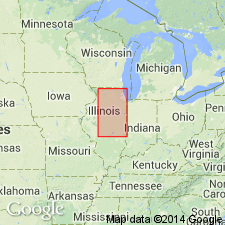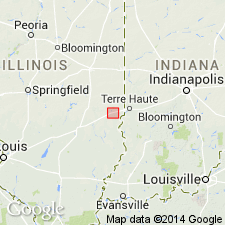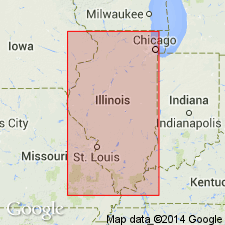
- Usage in publication:
-
- Parkland Sand
- Modifications:
-
- Original reference
- Dominant lithology:
-
- Sand
- AAPG geologic province:
-
- Illinois basin
Summary:
Pg. 78-79; Illinois Bull., no. 95, p. 231, 1975. Parkland Sand. Windblown sand in dunes and sheet-like deposits. Thickness commonly 20 to 40 feet; some dunes reach 100 feet high. Locally overlain by Richland Loess, Peyton Colluvium, or Lacon Formation. Occurs in central and northern Illinois. Age is considered Quaternary (Pleistocene and Holocene).
Type section: roadcut 5 mi west of Parkland, in SW/4 SE/4 SW/4 sec. 2, T. 23 N., R. 7 W., Tazewell Co., central IL. Named from village of Parkland, Tazewell Co., central IL.
Source: Publication; Hdbk Illinois stratigraphy (Illinois Geol. Survey Bull. 95, p. 231); US geologic names lexicon (USGS Bull. 1520, p. 233).

- Usage in publication:
-
- Parkland Sand
- Modifications:
-
- Areal extent
- AAPG geologic province:
-
- Illinois basin
Summary:
The Parkland Sand consists of predominantly fine to medium grained sand. Unit is as much as 5 ft thick in the study area and only locally present along an upland corridor about 0.5 mi wide east of the North Fork Embarras River valley.
Source: GNU records (USGS DDS-6; Reston GNULEX).

- Usage in publication:
-
- Parkland Sand†
- Parkland facies (informal)*
- Modifications:
-
- Abandoned
- AAPG geologic province:
-
- Illinois basin
Summary:
Pg. 18, 55, 57, 84, 85, 101. Parkland facies (informal) in Henry Formation of Mason Group; Parkland facies (informal) in Peoria Silt of Mason Group. Well sorted, medium- to fine-grained sand. Represents reworked eolian facies of the Henry; commonly occurs above glacial and postglacial fluvial and lacustrine sand and gravel of the Henry. Where it interfingers with the Peoria Silt, it may be more appropriately classified as Parkland facies (informal) in Peoria Silt. (Formerly Parkland Sand of Willman and Frye.) Age is Pleistocene (Wisconsinan Age; Woodfordian Subage), based on radiocarbon dating, and part is considered Holocene.
Source: Publication.
For more information, please contact Nancy Stamm, Geologic Names Committee Secretary.
Asterisk (*) indicates published by U.S. Geological Survey authors.
"No current usage" (†) implies that a name has been abandoned or has fallen into disuse. Former usage and, if known, replacement name given in parentheses ( ).
Slash (/) indicates name conflicts with nomenclatural guidelines (CSN, 1933; ACSN, 1961, 1970; NACSN, 1983, 2005, 2021). May be explained within brackets ([ ]).

